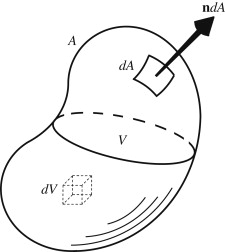Let \( V \) be a volume bounded by a closed surface \( A \). Consider an infinitesimal surface element \( dA \) having outward unit normal \( \mathbf{n} \) with components \( n_i \), and let \( Q(\mathbf{x}) \) be a scalar, vector, or tensor field of any order. Gauss’ theorem states that: \[ \iiint_V \frac{\partial Q}{\partial x_i} \, dV = \iint_A n_i Q \, dA \]

Illustration of Gauss’ theorem for a volume \( V \) enclosed by surface area \( A \). A small volume element, \( dV \), and a small area element \( dA \) with outward normal \( \mathbf{n} \) are shown
The most common form of Gauss’ theorem is when \( \mathbf{Q} \) is a vector, in which case the theorem is:
\[
\iiint_V \sum_{i=1}^{3} \frac{\partial Q_i}{\partial x_i} \, dV \equiv \iiint_V \frac{\partial Q_i}{\partial x_i} \, dV = \iint_A \sum_{i=1}^{3} n_i Q_i \, dA \equiv \iint_A n_i Q_i \, dA, \quad \text{or}
\]
\[
\iiint_V \nabla \cdot \mathbf{Q} \, dV = \iint_A \mathbf{n} \cdot \mathbf{Q} \, dA,
\]
which is commonly called the divergence theorem. The theorem states that the volume integral of the divergence of \( \mathbf{Q} \) is equal to the surface integral of the outflux of \( \mathbf{Q} \)
Alternatively, \(\iiint_V \frac{\partial Q}{\partial x_i} \, dV = \iint_A n_i Q \, dA\) defines a generalized field derivative, denoted by \( \mathfrak{D} \), of \( \mathbf{Q} \) when considered in its limiting form for a vanishingly small volume \(\boxed{ \mathfrak{D} \mathbf{Q} = \lim_{V \to 0} \frac{1}{V} \iint_A n_i Q \, dA} \) Interestingly, this form is readily specialized to the gradient, divergence, and curl of any scalar, vector, or tensor \( \mathbf{Q} \)
For a tensor of order one or higher, the divergence and curl are defined by including a dot (scalar) product or a cross (vector) product, respectively, under the integral \[ \nabla \cdot \mathbf{Q} = \lim_{V \to 0} \frac{1}{V} \iint_A \mathbf{n} \cdot \mathbf{Q} \, dA, \quad \text{and} \quad \nabla \times \mathbf{Q} = \lim_{V \to 0} \frac{1}{V} \iint_A \mathbf{n} \times \mathbf{Q} \, dA \]